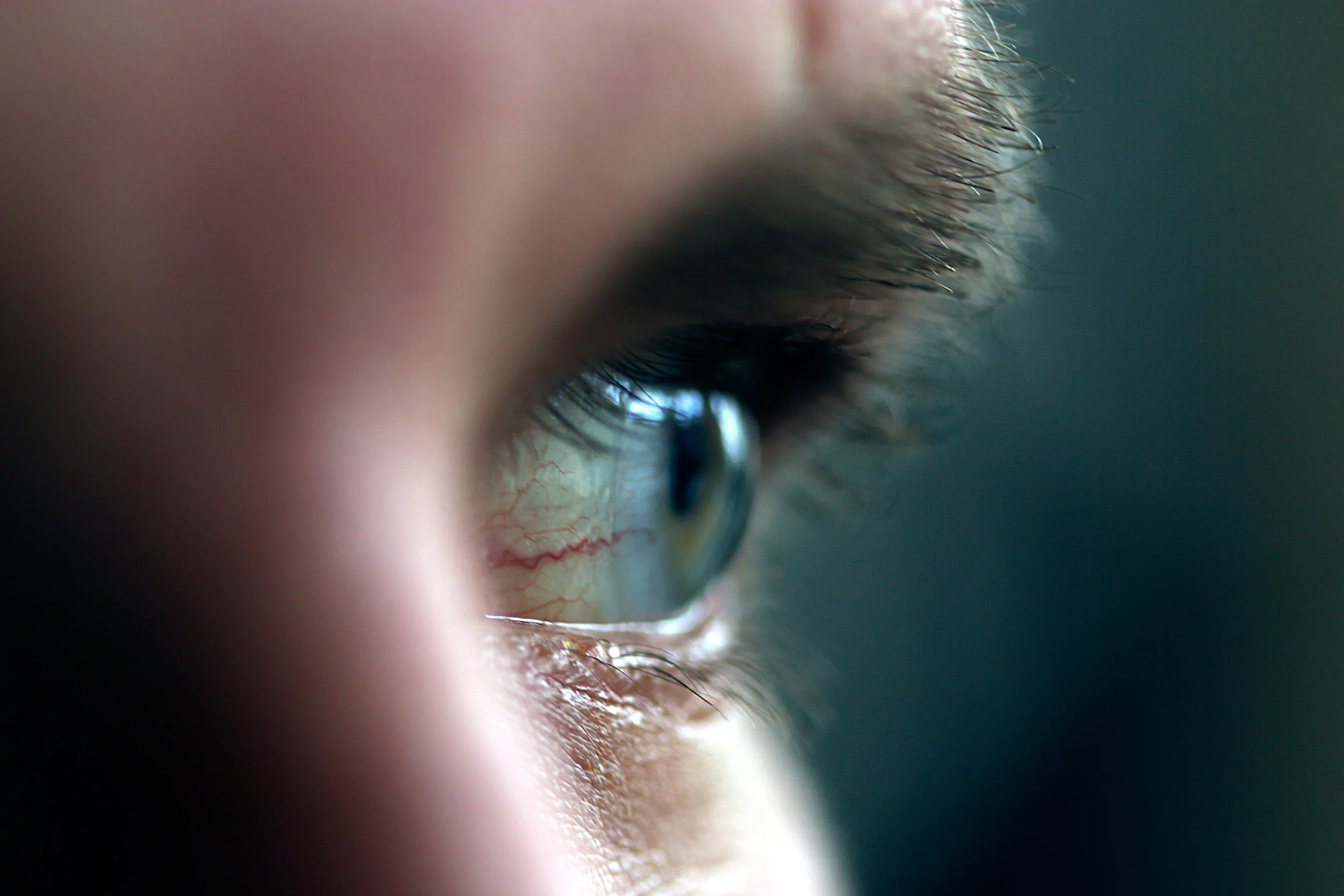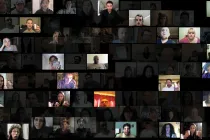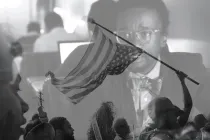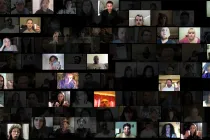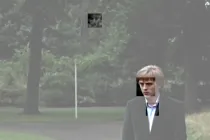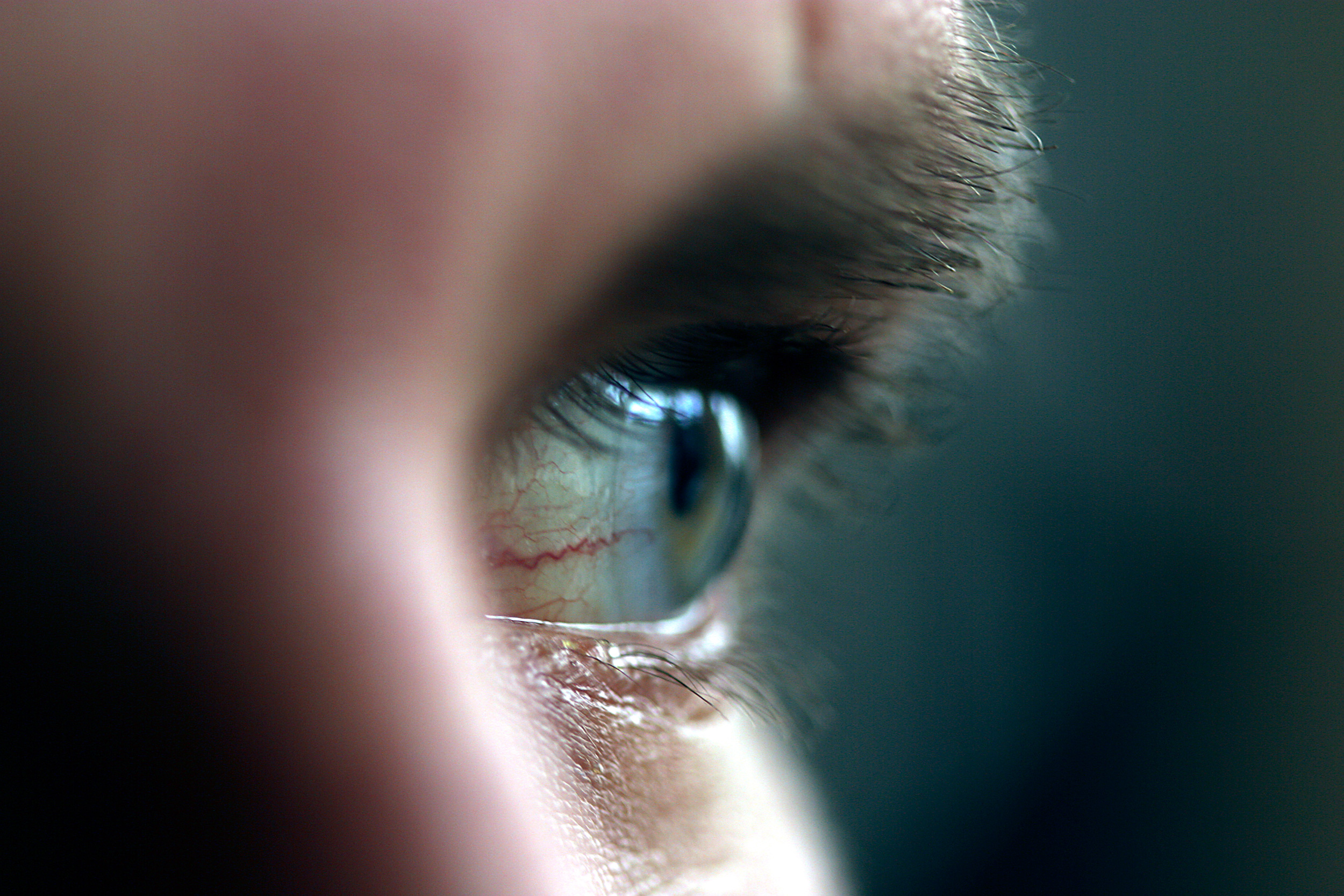
Shelly Silver is a New York–based artist working in film, photography, and video. Through her work Silver navigates the uncertain and unfixed boundaries between public life and private moments, document and fiction, observation and objectification. Her short film What I'm Looking For (2004)—a story of strangers seeking intimacy in public spaces through photography—is currently on view at the International Center of Photography Museum in the exhibition Public, Private, Secret, on view through January 8, 2017.
Silver has screened and exhibited her work widely, including at the Centre Pompidou, Paris; ICA London and Tate Modern, London; the Los Angeles Museum of Contemporary Art; the Museum of Modern Art, New York; and at the Berlin, London, Moscow, New York, and Singapore Film Festivals. She is Associate Professor and Director of the Moving Image in the Visual Arts Program at Columbia University School of the Arts.
Marina Chao: What I'm Looking For is currently on view at the ICP Museum. Can you describe the circumstances surrounding the genesis of this work? What made you want to reach out to strangers on an online-dating site with the request, “I’m looking for people who would like to be photographed in public revealing something of themselves […],” and document your interactions?
Shelly Silver: I had just finished Suicide (2003), a feature film in the form of a personal travel diary–cum–road movie, about a suicidal filmmaker who travels the globe in an effort to find a reason to go on living. The film weaves together dark, funny narration and eye-popping handheld images; its heroine implicates the viewer into witnessing her inappropriate and somewhat crazed projection onto whomever or whatever she finds in front of her. Filmed run-and-gun style in public spaces spanning fourteen countries over four peripatetic years, I was exhausted with inhabiting this woman’s zeitgeist. I wanted to continue this exploration that one could call “woman with a camera in public space,” but to flip the direction of the impulse. I wanted to capture images based on the desires of those in front of the camera. And so I started an experiment.
I wrote in my proposal to the Lower Manhattan Cultural Council (LMCC) Studio Residency that I wanted to capture “moments of intimacy” in Lower Manhattan through traditional street photography and by contacting interested subjects via Internet dating sites. I associate the word “intimacy” with closeness, friendship, affection, warmth, love, and sex. If one thinks of a word as bait, then “intimacy” opens a whole range of possible fish to catch.
On my dating site profile, instead of “intimacy,” I used the word “reveal.” I was curious to see how people would respond to this call, which would have to, in some way, engage the visual. I told each prospective model that I wanted them to show me what they wanted me to see. This request was met with confusion and resistance, and there was often a tussle, as many expected me to direct them. Considering the way we’ve been conditioned by a certain relationship between photographer and subject, this made sense.
The activity of taking the so-called street photographs wasn’t about locating visible examples of intimacy and pressing the shutter; the act of photographing itself felt like an intimate act. The experience brought me, for the brief time of framing and taking the photograph, into a one-sided intimate contact with the individual, couple, or crowd: I look at my subject; I experience a feeling of recognition; a connection emerges.
However, photographing the people I met through the Internet turned out to be a two-sided relationship. Each time I was about to meet a stranger for this unpredictable interaction I felt the pressure to perform. It was freezing outside, the winter days were short and there wasn’t much time to solve the puzzle of what I should do or say to pull out wants, ideas, and desires that would lead to the manufacture of an image. Most often, I think, the pressure to perform was mutual, although I clearly had more at stake. I photographed two people twice or more: the man from Japan, who had such a strong story to tell, and the man with the beautiful neck, who was a mystery to me until I realized that he also had a passion for looking. We became friends and I encouraged him to go to art school where he studied photography and then painting.
MC: What questions were you hoping to answer?
SS: The process was more experiential than intellectual; it was grounded in a process of discovery. What could moments of intimacy mean? What is visually revealed in public space and are these revealed moments meant to be public? What would the differences be between the two kinds of photographs? Would anyone show up? Now it’s pretty typical for people to solicit all sorts of things from these sites, but at the time, I had never heard of this happening. A question that I often asked myself, as I put on my thermal underwear before heading out the door, was: Why are you doing this?
Who is that character from Dostoevsky’s The Idiot who says, “I’m really here only to meet people”? Prince Myshkin?
MC: Were you ever nervous or afraid going into these encounters? I’m assuming you were alone when you were meeting the people who responded to your ad. There’s one man near the end of the piece who is somewhat confrontational, expressing his frustration at being asked to show you something when you’ve refused to give him your name. He says to you, “The bold are in front of the camera, the cowards behind it.” It’s a fascinating paradox: he’s so brash and arrogant, even while stripping down to his socks and underwear in the middle of a Manhattan street for your photograph. What was your overall experience with the people you met during this project? This somewhat evolves over time and through multiple meetings, but how did they handle the vulnerable positions they had opted into? Did anything surprise you about how they navigated the experience?
SS: I was nervous, absolutely. So I made rules. I broke contact with anyone I thought was crazy and I never gave my name or address, just my cell phone number, procured especially for the project. Otherwise I would meet anyone, always in public space, most often at the Starbucks in the Woolworth building where my LMCC studio was located. We’d meet, they’d sign a release form, and we would order nothing. As with my unauthorized use of the Internet dating site for the project, I saw an opportunity, to mis/use a corporate phenomenon to my advantage. Starbucks became my anonymous, rent-free office.
Otherwise, I used my intuition and hoped for the best. For example, the confrontational gentleman you mentioned insisted on meeting me on a quiet corner in Tribeca at 10 p.m. on an extremely cold night. He pulled up in his car, rolled down his window, and said, “Get in.” I had to make a quick assessment. I got into his car and it could have turned out badly, but it didn’t. We talked as his heater blasted lukewarm air, he told me what he wanted to do, and then we got out of the car and he did it. Afterwards we went for pizza. And then there was the man from London, the only one who sent me photos. This long-term correspondence was surprising, not only because of who he was and what he wanted. The interaction was unlike any I had had previously, calling on me to do things I’d never thought of doing.
It’s interesting that you describe the subjects as being vulnerable. Perhaps the man who undressed to his socks and underwear was acknowledging this vulnerability by making me get into his car, putting me in what we both knew was a threatening situation. It was a form of equalization. A power and gender reversal that’s never fully reversed…or that’s reversed again, then recouped. Of course, in the finished film, the power rests firmly in the hands of the fictional narrator/photographer.
The dating site I used was Salon.com, which also linked the Village Voice personals as well as a slightly kinkier site, Nerve. This was great, as the three together enlarged the demographic quite a bit. In my profile I checked all the possible boxes, which meant: Men or women for a short-term relationship, a long-term relationship, a friend, an activity partner, or play, aged 18–99, which are the limits. I had no preferences regarding education, religion, ethnicity, body type, drugs, or smoking or drinking habits. I tried using several different profile photographs, and finally had the most success with a commercial lightbox image of a woman’s closed eye. The sifting process was done by the website itself, ensuring that the men who contacted me identified themselves as looking for a woman—straight, bi, or queer, though that word wasn’t as commonly used in the early 2000s as it is now. I imagine that most of the women were lesbian, bi, or queer, although I can’t say that definitively. It was one of the surprise results and, frankly, a disappointment that out of the women who contacted me none showed up. Men were intrigued and willing; women less so, or not enough to go through with it. There’s also a question of trust and perceived safety.
What did they want from me? Each person wanted something different from the experience, which is often the case when asking someone to participate with no motivation of money. I could guess, but I couldn’t say.
MC: In this work, you play with the documentary form, both in film and photography. There’s an immediate sense as you watch the film that it isn’t all fiction—something in the immediacy of the photographs and the intimacy of the voiceover reveals this—but the hand of the artist is effectively visible in the narrative style and in the editing. What, for you, is the value in this slippage between fact and fiction, or documentary and narrative?
SS: I wouldn’t call What I’m Looking For a documentary, although I had to confront, during its production, a standard set of documentarians’ ethical issues. Above all, I felt a responsibility toward my collaborators to represent our interaction as accurately as possible. Otherwise, I took great pleasure in shaping the character of the narrator, her tone and use of language, as well as the overall arc of her narrative. She is not my double, and for that reason I found her seductive.
The formal decisions I made in the making of What I’m Looking For were, in part, motivated by how best to bring out the different dynamics: between the model and the photographer, the audience and the photographer, the audience and the model, one still frame and the next. The space for the dance of projections comes from the play between the distance, closeness, and unknowability of these various positions. It’s what enables the web of projection, identification, and pleasure.
MC: This something you explore in your other films as well. Could you put What I’m Looking For in the context of your larger body of work?
SS: A more recent example of my play between genres is Touch (2013), a film about a gay man who goes back to Chinatown, New York City, to take care of his dying mother. Although it is fiction, it was filmed with what could be called an observational documentary style as opposed to a narrative style. I’ll try to locate the difference: Whereas documentaries have a range of conventions and shooting and editing styles, fiction films almost always concentrate on the faces, the eye trace, and the “shot–reverse shot” between characters to drive the story. These protagonists are put into credibly built spaces, they are established in locations, they can be seen walking through it, even looking at this landscape or street, in which case we get a brief cut to see what they’re looking at. But the place is always subservient to the character and story.
Touch is ostensibly filmed by the main character. We never see this fictional filmmaker, and only rarely does someone appear to interact with him, with a nod or look to the camera. The camera is most often on a tripod, so we can’t intuit the movement of his body or eyes, except through edits and voiceover. This means that we spend sixty-eight minutes looking at his location and his neighborhood. The man and the Chinatown neighborhood form the main relationships of the film. There’s a third protagonist, who we also never see, whom the man addressed lovingly, or mockingly, as “you.” This character, who follows him, watching what he watches, seeing what he’s showing, is his audience, the viewer. That character is us.
Finally, I wouldn’t frame this question as truth vs. non-truth, fact vs. fiction; I’d first frame it as a question of slippage between genres, of film languages. Each genre has its own use of convention, expectation, and framing. The active pleasure I get in refusing to abide by the rules of genres is clear from my first films from the 1980s. PBS told me that they didn’t want to show Meet the People (1986), which doesn’t reveal until the end credits that the people in front of the camera are actors. They said they were afraid of angering their audience. It was a different world then, well before mockumentaries and so-called reality television. Much of my early works addressed mainstream media directly and aggressively, convincingly mimicking the look of a genre while emptying out its traditional face value–use as an educational tool, in the case of a documentary, or as a way to sell the viewer something, in the case of advertising. I was aiming to destabilize and subvert my own as well as viewers’ assumptions about what they were watching and why they were watching it, building a different way of navigating and reading the moving image.
Every film, every small machine that shares moving parts with other machines, is built differently for specific reasons. I’d have to answer this question separately for each project, as each one strategically and poetically uses the components in another way. In my many decades of making these formal decisions, the different media worlds—mainstream, experimental, artistic—have also changed, and strategies get co-opted; they might work once but not the next time and I find myself having to move on.
I’ve been thinking a lot about genre and expectation as we, the public, shift from mainstream media—broadcast television news, magazines, and newspapers, which have moderate controls and accountability—to the Wild West world of social media. This has been in full focus after the recent election. We’re being told that we’re in a time of the “post-factual” and “post-truth.” The normalizing of these word phrases, our acceptance of them and the situation that they describe, has frightful implications. For example, the rebranding of the word “alt,” as in “alternative,” on the part of a white nationalist group represents a cleaning or disconnecting of a word that is otherwise used to describe something better. Historically, artistic tropes have always gotten co-opted and cannibalized. The artist’s role is always one of recalibrating, of finding new cracks in the system, new ways of speaking. It’s time for new strategies.
MC: Could you speak to the format of What I’m Looking For? It is made up entirely of still photographs edited into a continuous film, rather than moving footage. From the narrative it seems that you always intended to make photographs rather than shoot film for this project. What factors—formal, practical, and conceptual—influenced this decision? What about the nature of photography did you want to use or question as you conflated the mediums of still photography and video?
SS: The original project was meant to be a series of photographs. I started out as a photographer, and I wanted to go back to making non-ephemeral objects that weren’t in need of additional technology for display, that could hang on a wall and be looked at. I wanted to take a break from the relentless editing that my projects require. I was curious to find out how it would feel, what the differences would be, in capturing one image as opposed to thousands or tens of thousands at a time. How might it make me see and think differently?
And then I photographed the man from Japan, who talked about the destruction of the World Trade Center, the earthquake in Kobe, and the bombing of Hiroshima. I met with him twice, trying my best to photographically tell his story, and I decided I couldn’t. The question the narrator asks at the end of his sequence—“Can a photo capture this?”—was also my own. I decided it could not, and at this point thought, Damn, I’m going to have to turn this into a film.
What I’m Looking For also exists in an installation version, which expands on the project’s approach to the complexity of the still image. It was commissioned by the film theorist Raymond Bellour and curator Sérgio Mah for the aptly named show State of the Image: Instants and Intervals (Estados da Imagem: Instantes e Intervalos) at Lisboa Photo in 2005. The installation incorporates fifty-four classically framed photographs, some of which were also included in the film, depicting narrative scenes and still moments from the film itself, as well as hundreds of sheets of documentation from the online-dating website, the profiles of the many people who contacted me over the course of the making of the project, displayed in a large grid. The profiles addressed another level of photographic self-representation in a public and private sphere: they were available on the Internet for all to see and contain so much that we would consider private, but they were not intended to be printed out and displayed on a museum wall. Bellour writes: “The distress these pages cause is huge. Hence it induces an effect of concomitant reality to its imaginary capacity. We can also read, into life itself, that which each participant of the www.personals.salon.com is ‘looking for.’ Lives are handed over well across truths that are equally masks. Desires are expressed, the fictions of desires try to become true.”
MC: And how much was Chris Marker’s La Jetée (1962)—its form and the questions it raises about memory, fantasy, and desire—a direct influence?
SS: Chris Marker is someone I’ve been in a one-sided dialogue with since 1998, when I started to film Suicide. I never actually reached out to him, something I now regret. Like Marker’s Sans Soleil (1983), Suicide was shot in many places, though largely in Japan, by someone filming in public. The films share commonalities, overlaps, and disagreements—at times the main character Amanda speaks directly to Marker. When writing What I’m Looking For, I returned to thinking about Sans Soleil, which is in part about a man filming and commenting on the people he shoots, many of them women. It is also a fictional essay–film shot in a personal diary–like documentary style, and Marker uses narrative displacement, a fictional female narrator receiving letters from a cameraman, to tell the story. The film is punctuated by the lovely phrase, “he writes from…” which my narrator, twenty years later, echoes when speaking of the many men and women who have sent her messages through the Internet, desiring to be captured by her lens. Both films flirt with the confessional and the secretive, but the positions and genders permutate.
La Jetée, Marker’s brilliant still-image film is often referenced in relationship to What I’m Looking For, and it’s true that both use still images. But La Jetée, still images aside, is at heart a narrative fiction film, with its main protagonists falling in love within the structure of shots and reverse shots. Sans Soleil, like What I’m Looking For and Suicide, is a film about one person filming, though it was actually filmed by many. It is a film founded on the desire between the out-of-sight cameraman and the letter-reading female narrator, as well as on the cameraman’s relationship to the world that he intently watches, that we watch with him. It is a web of desire that entangles everyone and everything.
MC: In Public, Private, Secret we’re exploring, in part, the persistent human impulses that drive us to seek intimacy, which require us to cross emotional and physical boundaries. We then weave in an exploration of how these attempts to connect have evolved as technology has become more pervasive. If there were something about how technology was changing our relationships that inspired you to make What I’m Looking For in 2004, how would you characterize the landscape now, more than a decade later? Can you imagine what the next big paradigm shift could be? I might be asking you what your episode of Black Mirror would look like.
SS: The landscape has indeed changed and will continue changing: Facebook started in 2004, after What I’m Looking For was completed, then Twitter began in 2006, Tumblr in 2007, Grindr in 2009, Instagram in 2010, Snapchat in 2011, Tinder in 2012, etc. The way we interact interpersonally, the ubiquity and extreme use of cell phones and the decline of the mainstream media, in particular broadcast news and newspapers…I’m answering this question two weeks after the day that Donald Trump was elected as president so I still find it hard to give you an entirely rational response, except to say, as an overwhelming understatement, that things have changed. The landscape is not looking good because we are losing the ability as a society to regulate the content of mass communication. There are no longer checks and balances, such as the FCC (Federal Communication Commission), to ensure a modicum of control over information, and I’m concerned both about surveillance and information gathering on the Internet, as well as threats to net neutrality. Interesting that you bring up Black Mirror. In the episodes I’ve watched I was struck by how much it reminded me of the original Twilight Zone TV show, which came out in the aftermath of the McCarthy era. In both shows, one can feel the paranoia dripping down every frame. I was surprised that in the chapters I’ve watched, Black Mirror has an unquestioning though not always cheery insistence on individual heroes, couples, or families. There is something very old-fashioned, very fifties, about the way of life and the organization of people that it portrays.
MC: To end, I’ll ask the unanswerable question that weaves through so much of your work: Do any of us ever find what we’re looking for, or is that a fallacy? Is there something eternal about desire?
SS: This question is a complicated one, tied to our culture, to the deeply ingrained way we think about ourselves, but also to the system of advanced capitalism, which runs on a never-ending flow of manufactured desires that must be endlessly fed, that structurally will and can never be satisfied. Without this cycle, neoliberalism, the economic system that we live under, collapses, perhaps in a very ugly way; however, if we maintain this endless addiction to consumption and growth, we will bring about the end of the world. And then there’s the cheery cashier at the big box store who asks, “Did you find what you were looking for?” which you can answer with a simple “Yes,” pointing to the toothpaste and donuts in your cart. The title What I’m Looking For comes from a slight rewrite of the last prompt on the Internet dating site: “More about what you’re looking for.” I was drawn to this phrase and not only because of its callout to the act of looking. It would be a mistake to say all desire is eternal and unrequited. It’s as simple as clicking on a profile to find sex, love, companionship, or someone eager to be photographed. You are more of a Lacanian than you know!
Perhaps I’ll veer slightly from the word “desire,” which has a complex linguistic, psychological, and philosophical history, and bring in the words “time,” “solitude,” “connection,” “finitude,” and “plenitude.” The film has an underlying sense of time and time passing, whether it’s the years between a nuclear bomb, an earthquake, and a plane flying into a building, referenced by a visitor from Japan, or a London man’s uncanny ability to digitally freeze the precise moment of his ejaculation. There is a sense of physical fragility, and not only in the image of a man’s naked armpit. It references closeness and death, which is something that Roland Barthes and Marguerite Duras, among others, write so movingly about in relationship to photography. The character of What I’m Looking For is susceptible to the open structure of desire, her camera is open to whoever passes in front of her, whoever contacts her online. And even if only for a fraction of a second, she is connected and has the evidence to prove it.
A person is always a partial being—we are partial beings, it’s only our culture that tells us otherwise, that insists on our unity and singularity. We are thus always in the throngs of desire, if desire means both reaching out and taking in. The act of looking is a taking in. If our eyes are closed, our ears remain open, our skin—the largest organ in our body—is ever-vibrating with interaction. Desire is not only for something or someone; it also functions outward from the body, from the mind, for stimuli, for interconnectivity, for touch, air, sound. It doesn’t mean that we don’t find, at any particular moment, what we’re looking for.
This interview was originally published on publicprivatesecret.org on December 14, 2016.


